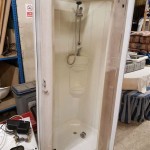Stand Up Shower Tub: A Comprehensive Guide
Combining the functionality of a shower with the comfort of a bathtub, stand up shower tubs offer an ideal solution for small bathrooms or for those who prefer a more accessible bathing experience. This comprehensive guide will delve into the essential aspects of stand up shower tubs, including their benefits, types, features, and installation considerations.
Benefits of Stand Up Shower Tubs:
Accessibility:
Stand up shower tubs eliminate the need to step over a high threshold, making them suitable for individuals with limited mobility or those with accessibility needs.Safety:
The walk-in design and non-slip surface reduce the risk of slips and falls, providing a safer bathing environment.Space-Saving:
Compared to traditional showers, stand up shower tubs require less floor space, making them an ideal choice for compact bathrooms.Convenience:
The built-in seating or grab bars provide support and comfort, allowing for a relaxing bathing experience.Types of Stand Up Shower Tubs:
Alcove:
These tubs are three-sided and fit into a corner of the bathroom, providing a compact and space-efficient option.Freestanding:
Freestanding tubs are not attached to the walls, offering greater flexibility in placement and a more luxurious look.Soaking:
Soaking tubs feature a deeper design, allowing for a full-body immersion experience.Barrier-Free:
Designed for wheelchair users, barrier-free tubs have a low threshold or no threshold at all, ensuring easy access.Features to Consider:
Materials:
Stand up shower tubs are typically made of acrylic, fiberglass, or cast iron. Acrylic is lightweight, durable, and easy to clean, while fiberglass is more budget-friendly but less durable. Cast iron provides the most durability but is also heavier and more expensive.Size:
The size of the tub should accommodate the height and weight of the user. Consider the available space in your bathroom and choose a tub that fits comfortably.Shape:
Stand up shower tubs come in a variety of shapes, including rectangular, square, round, and oval. Select a shape that complements the aesthetics and layout of your bathroom.Installation Considerations:
Plumbing:
Stand up shower tubs require proper plumbing for both the shower and tub functions. Ensure that your bathroom has the necessary plumbing fixtures and connections.Framing:
The walls around the bathtub may need to be reinforced to support the weight of the tub and its contents.Accessibility:
Consider the height and threshold of the tub in relation to the user's accessibility needs. Installing a grab bar or seat can enhance safety and convenience.Conclusion:
Stand up shower tubs provide a versatile and accessible bathroom solution, offering benefits such as safety, space-saving, and convenience. By understanding the different types, features, and installation considerations, you can choose the ideal stand up shower tub for your bathroom and create a safe and comfortable bathing experience.
Guide For Freestanding Tubs Signature Hardware

How To Convert A Tub Walk In Shower Diy Guide

Why You Might Want To Put Your Tub In The Shower

Guide How To Choose A Freestanding Tub 2024

Full 3 4s And Half Bathrooms 2024 Sizes Layout Guide
Guide For Freestanding Tubs Signature Hardware
:max_bytes(150000):strip_icc()/__opt__aboutcom__coeus__resources__content_migration__treehugger__images__2017__12__dirks-b646ebe8959643e49f5d634ab5c799c8.jpeg?strip=all)
Shower Or Tub Which Is Right For You

Guide To Standard Walk In Shower Dimensions And Sizes
Guide For Freestanding Tubs Signature Hardware

How Much Does A Walk In Tub Shower Combo Cost Modernize
Related Posts








